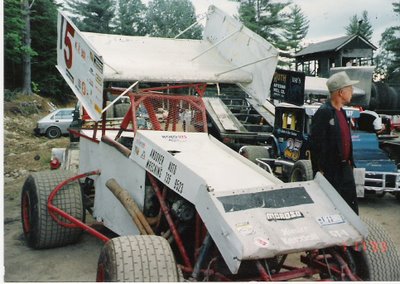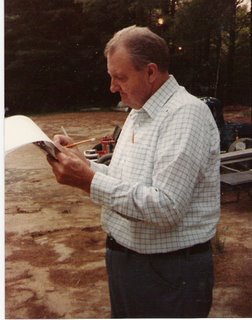Buck and Big Bill
 Bill Moses, taking a victory lap
Bill Moses, taking a victory lap
If you’ve spent any time around race tracks in New Hampshire, you’ve undoubtably heard the name Moses. I am proud to be able to call a number of the Moses family my friends, but two of the clan that impressed me the most are the father-and-son team of Buck and Big Bill Moses.

I can remember Buck driving his own car back in the ‘60’s at the 106 Midway Raceway in Loudon. (More on that place later.) One of my all-time favorite racing stories features Buck, and his nemesis Paul Martel. One year, the two were neck-and-neck for the track championship going into the last week of the season. Paul blew his engine in the qualifier, and all Buck had to do to take the title was line up for the green flag in the feature. Instead, he loaned his car to Martel. Now, if you wrote that into a piece of fiction, nobody’d buy it. It’s too ridiculous. My dad was the pit steward, and I swear to God it happened just that way.
The one thing I remember most about Buck is that he could do more with less than any car builder I ever heard of. He also wasn’t above seeing how far the rule book could be bent. Once, he brought his car with some new “improvement” into the pit at 106. Dad found it, and asked Buck about it. Buck protested that it was legal, and he should be allowed to run it. To his surprise, Dad agreed. That REALLY got him mad.
“You mean, EVERYBODY’S going to be allowed to run that way?” he protested.
Still, I think if my life was on the line over a race, I’d want Buck to build my car.
I think even Buck would agree that, as successful as he was as a driver, Big Bill was better at it than he was. There were, of course, two Bill Moses’. There was Buck’s son, and Buck’s brother, Dusty, also had a son named Bill. Dusty and his Bill were both musicians, so the other became known as “Billy Gee-tar.” Gee-tar Bill has some recordings somewhere on the web, and if he or somebody he knows reads this, maybe they’ll leave the link in the comments. (HINT!!)

Bill at Nor-Way Pines
Gee-tar Bill also raced, and was very good at it, but Big Bill was truly one of the greats. With Buck building his cars, he went from victory to victory and made it look easy. They were the last team I ever saw run a flathead Ford, and the last season they did they were still winning features with it. When they finally gave up the flatty and switched to a straight-6 Ford truck engine, Big Bill won the track championship at the Nor-way Pines. They were also the first I ever saw try an independent rear suspension on a dirt-track car. Somehow, Buck came up with a rear end out of a Corvette, and they spent half a season trying to get it to hook up properly. Never did get it to work quite right, but nobody else could have done half as well with it either.
I got into trouble with Bill once when I was track announcer at the Nor-Way Pines, over one of Buck’s clever innovations. They had built a new car and from what I hear they didn’t have enough money to put a proper body on it. Instead, somebody gave them some corrugated aluminum swimming pool lining, so they rivetted it onto the bare frame and went racing. When I heard that, I thought it was a great idea. What turned out to NOT be a great idea was my decision to call the new car “The Flying Bathtub.” Now, most racers have a sense of humor about the nicknames I make up, but Bill was actually planning to hit me with a pie. He was really mad! Of course, I apologized, and swore I’d never use the offensive name again. I honestly didn’t think there’d be a problem, because most of the other racers only saw it from the rear anyway.
I think it broke everybody’s heart to hear about Big Bill’s passing. It happened during the off-season, and I don’t recall what year it was, or what the situation was. I’m hoping somebody will post something to the comments section and give us the details. I know the loss was felt by everybody in the racing community. Bill was a great guy, and if he’d never won a race in his life there’s an awful lot of people who would still miss him. No matter how he did on the track, he was a true champion.

Buck, Sarah, and Bill
The last I knew, Buck is still with us, although I haven’t seen him in years and I don’t know if he still goes to the races. Bill also had a daughter, Sarah, who’s quite a race driver in her own right. Sarah married another good driver, Sam Comeau, from another racing family that includes such dirt track heroes as “Flying” Franny Comeau and “Hard Luck” Harold Hannaford. And, of course there’s the endless parade of Moses cousins, etc. who keep the dirt flying wherever they go. “Prince” John, Ray, Billy, Royal, and the rest of the gang. Good people, every last one of ‘em.
 Bill Moses, taking a victory lap
Bill Moses, taking a victory lapIf you’ve spent any time around race tracks in New Hampshire, you’ve undoubtably heard the name Moses. I am proud to be able to call a number of the Moses family my friends, but two of the clan that impressed me the most are the father-and-son team of Buck and Big Bill Moses.

Buck, in front of Bill's car
I can remember Buck driving his own car back in the ‘60’s at the 106 Midway Raceway in Loudon. (More on that place later.) One of my all-time favorite racing stories features Buck, and his nemesis Paul Martel. One year, the two were neck-and-neck for the track championship going into the last week of the season. Paul blew his engine in the qualifier, and all Buck had to do to take the title was line up for the green flag in the feature. Instead, he loaned his car to Martel. Now, if you wrote that into a piece of fiction, nobody’d buy it. It’s too ridiculous. My dad was the pit steward, and I swear to God it happened just that way.
The one thing I remember most about Buck is that he could do more with less than any car builder I ever heard of. He also wasn’t above seeing how far the rule book could be bent. Once, he brought his car with some new “improvement” into the pit at 106. Dad found it, and asked Buck about it. Buck protested that it was legal, and he should be allowed to run it. To his surprise, Dad agreed. That REALLY got him mad.
“You mean, EVERYBODY’S going to be allowed to run that way?” he protested.
Still, I think if my life was on the line over a race, I’d want Buck to build my car.
I think even Buck would agree that, as successful as he was as a driver, Big Bill was better at it than he was. There were, of course, two Bill Moses’. There was Buck’s son, and Buck’s brother, Dusty, also had a son named Bill. Dusty and his Bill were both musicians, so the other became known as “Billy Gee-tar.” Gee-tar Bill has some recordings somewhere on the web, and if he or somebody he knows reads this, maybe they’ll leave the link in the comments. (HINT!!)

Bill at Nor-Way Pines
Gee-tar Bill also raced, and was very good at it, but Big Bill was truly one of the greats. With Buck building his cars, he went from victory to victory and made it look easy. They were the last team I ever saw run a flathead Ford, and the last season they did they were still winning features with it. When they finally gave up the flatty and switched to a straight-6 Ford truck engine, Big Bill won the track championship at the Nor-way Pines. They were also the first I ever saw try an independent rear suspension on a dirt-track car. Somehow, Buck came up with a rear end out of a Corvette, and they spent half a season trying to get it to hook up properly. Never did get it to work quite right, but nobody else could have done half as well with it either.
I got into trouble with Bill once when I was track announcer at the Nor-Way Pines, over one of Buck’s clever innovations. They had built a new car and from what I hear they didn’t have enough money to put a proper body on it. Instead, somebody gave them some corrugated aluminum swimming pool lining, so they rivetted it onto the bare frame and went racing. When I heard that, I thought it was a great idea. What turned out to NOT be a great idea was my decision to call the new car “The Flying Bathtub.” Now, most racers have a sense of humor about the nicknames I make up, but Bill was actually planning to hit me with a pie. He was really mad! Of course, I apologized, and swore I’d never use the offensive name again. I honestly didn’t think there’d be a problem, because most of the other racers only saw it from the rear anyway.
I think it broke everybody’s heart to hear about Big Bill’s passing. It happened during the off-season, and I don’t recall what year it was, or what the situation was. I’m hoping somebody will post something to the comments section and give us the details. I know the loss was felt by everybody in the racing community. Bill was a great guy, and if he’d never won a race in his life there’s an awful lot of people who would still miss him. No matter how he did on the track, he was a true champion.

Buck, Sarah, and Bill
Three generations of racing Moses'
The last I knew, Buck is still with us, although I haven’t seen him in years and I don’t know if he still goes to the races. Bill also had a daughter, Sarah, who’s quite a race driver in her own right. Sarah married another good driver, Sam Comeau, from another racing family that includes such dirt track heroes as “Flying” Franny Comeau and “Hard Luck” Harold Hannaford. And, of course there’s the endless parade of Moses cousins, etc. who keep the dirt flying wherever they go. “Prince” John, Ray, Billy, Royal, and the rest of the gang. Good people, every last one of ‘em.







